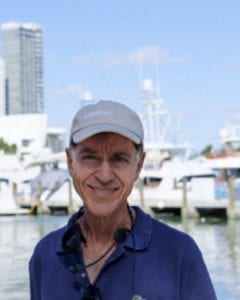|
Getting your Trinity Audio player ready...
|

We will complete our examination of Smith’s Casino, Miami Beach’s first tourist facility, in an upcoming issue of this column, but I want to turn first, with the holiday season already upon us, to an examination of the fledgling City of Miami’s first holiday observance.
Miami contained far less than 1,000 residents in December 1896, just eight months after Henry M. Flagler’s Florida East Coast Railway arrived to birth a new city. An air of anticipation filled the community as Christmas neared. Like today, tourists were streaming into the nascent city, stores offered special Christmas products, and a broad array of activities were planned for the holiday.
Miami’s first newspaper, the Miami Metropolis, a weekly appearing each Friday, wrote glowingly of the season. The journal was struck by the number of tourists arriving from many states, including Massachusetts, Connecticut, New York, Ohio, and even far-away California and Montana. Many stayed at the Hotel Miami, also known as the Miami Hotel, the hostelry of Julia Tuttle, Miami’s “Mother.” This imposing, three-story hotel was still unfinished, but in the final stages of construction, when Christmas dawned. Other guests stayed at the smaller Connolly House.
While many visitors were arriving, some residents planned to spend Christmas elsewhere. John Sewell, one of the city’s first retailers and a leading member of the Flagler organization, which was helping build Miami, spent Christmas with family in Kissimmee, while Frank Budge, who owned one of the city’s first hardware stores, celebrated the holidays in Titusville. Still, Budge’s Hardware invited Miamians to “Come and See Our Large Stock of Christmas Goods, Fancy Crockery, Etc.” Another hardware store, Watson’s, was filled with holiday gifts of every description, bragging that they were “ornamental, durable and serviceable,” and were of an “assortment that would be a credit to a Jacksonville house.” J.T. Feaster’s market advised readers to get their “fresh butter, eggs, chickens, and Christmas turkey.”
The departures of Sewell, Budge and others did not affect the enthusiasm for the upcoming holiday. A fireworks display was scheduled for Christmas Eve, while many of the women of the community planned a big Christmas Day party for the 155 white school age children in the casino of the Hotel Miami with a tree, carols, and presents for all. Black Miamians, separated from white Miami by the strictures of Jim Crow, or racial segregation, planned a “comic parade” for their own children Christmas morning in their quarter, known as Colored Town.
The busy Hotel Miami was also the gathering place for a Christmas Eve program, “the first of its kind in the history of Miami,” to be “rendered by children.” The Metropolis observed that the ladies were working hard to make (the event) a success.” The journal also printed its wishes for all Miamians that holiday season: “May no sickness or distress or adversity darken your doors this Christmas. May you be happy and gay.”
Four couples used the occasion of Christmas Eve to marry. Another couple, Charles J. and Phoebe E. Rose, celebrated their forty-seventh wedding anniversary.
Literally looming over the city during its first holiday season was the hulking Royal Palm Hotel– rising near the confluence of Biscayne Bay and the Miami River– then in its final stages of construction. Although Henry Flagler’s stunning hostelry would not officially open until January 17, 1897, it welcomed two guests on the eve of Christmas. John Jacob Astor, scion of one of America’s wealthiest families, and his son, Vincent, were guests at the hostelry at that time. While John Astor fished with Charlie Thompson, a renowned fishing guide, hotel employees hastily felled a nearby Dade County pine tree, moved it into the lobby of the building, and decorated it with whatever ornaments they could locate. A hotel clerk remembered that young Vincent appeared on Christmas morning adorned in a white sailor suit.
By then, the rest of the city was celebrating its first Christmas as an incorporated entity. The day passed without incident. John N. Lummus, a leading light who managed the Hotel Miami and who would later become the first mayor of Miami Beach, celebrated his twenty-third birthday, while Margaret McCann, born one week earlier, was baptized by Father A.M. Fontan, a Jesuit priest who was charged with organizing the Church of the Holy Name, today’s Gesu Catholic Church.
If Christmas Day passed without incident, the following day was anything but, as a ruinous fire erupted in the wee hours of the morning, destroying much of the young city’s business sector. We will examine this catastrophe in our next column.
Paul S. George, Ph.D., serves as Resident Historian, HistoryMiami Museum. He conducts history tours throughout the County and even beyond for HistoryMiami. Additionally, he teaches classes in Miami/S. Florida and Florida history for the Museum. Dr. George has also led, since 2002, tours of Little Havana as part of Viernes Culturales, a monthly celebration, every third Friday, of the culture and history of that quarter.





